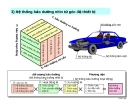
P-ISSN 1859-3585 E-ISSN 2615-9619 https://jst-haui.vn SCIENCE - TECHNOLOGY
Vol. 60 - No. 11 (Nov 2024) HaUI Journal of Science and Technology 5
OPTIMIZING POWER DISTRIBUTION NETWORK
RECONFIGURATION WITH QUANTUM PSO:
INCORPORATING SOLAR POWER AND ELECTRIC VEHICLES
TỐI ƯU HÓA TÁI CẤU TRÚC MẠNG PHÂN PHỐI ĐIỆN VỚI QUANTUM PSO:
KẾT HỢP NĂNG LƯỢNG MẶT TRỜI VÀ XE ĐIỆN
Nguyen Thanh Hoan1, Truong Viet Anh2, Nguyen Tung Linh3,*,
Nguyen Huu Vinh1, Truong Dinh Nhon2
DOI: http://doi.org/10.57001/huih5804.2024.359
ABSTRACT
The solar energy source (PV) is rapidly developing in Ho Chi Minh City, along with the promising increase in electric
vehicle (EV) charging stations connected
to the distribution grid. Ensuring the reliability of power supply and power quality is becoming a significant concern. To me
et this demand, the problem of grid
reconfiguration to minimize losses and optimize the us
e of renewable energy, considering the integration of EV charging stations, has become an essential
approach in grid operation management. Various algo-
rithms have been explored for the grid reconfiguration problem, with Particle Swarm Optimization (PSO)
being highly regarded and still actively developed for application today. In this study, the Quantum-
PSO (QPSO) method is proposed to enhance the global
search performance and convergence ability of PSO by incorporating concepts from quantum mechanics. The
QPSO method was tested alongside Binary PSO
and PSO on the same grid model to compare these methods. The results have been applied and verified on the IEEE 33-
bus grid model, with parameters adjusted
for distribution grid re-configuration, in two scenarios: before and after the integration of solar en-
ergy and EV charging stations, confirming the accuracy and
reliability of the proposed method.
Keywords: PSO, Binary PSO, Quantum PSO, QPSO, Power losses, Particle Swarm Opti-mization, Anomaly Detection, Reconfiguration Power Distribution Networks.
TÓM TẮT
Nguồn năng lượng mặt trời (PV) đang phát triển nhanh chóng tại Thành phố Hồ Chí Minh, cùng với sự gia tăng đầy hứa hẹn của các trạm sạc xe điệ
n (EV)
kết nối với lưới điện phân phối. Đảm bảo độ tin cậy của nguồn cung cấp điện và chất lượng điện năng đang trở thành một mối quan tâm đáng kể. Để đáp ứ
ng
nhu cầu này, vấn đề tái cấu trúc lưới điện nhằm giảm thiểu tổn thất và tối ưu hóa việc sử dụng năng lượng tái tạo, có tính đến sự tích hợp của các trạm sạc EV, đ
ã
trở thành một phương pháp quan trọng trong quản lý vận hành lưới điện. Nhiều thuật toán đã được nghiên cứu cho vấn đề tái cấu trúc lưới điện, trong đó Tố
i ưu
hóa bầy đàn (PSO) được đánh giá cao và vẫn đang được phát triển tích cực để ứng dụng ngày nay. Trong nghiên cứu này, phương pháp Quantum-
PSO (QPSO)
được đề xuất để nâng cao hiệu suất tìm kiếm toàn cục và khả năng hội tụ của PSO bằng cách kết hợp các khái niệm từ cơ học lượng tử. Phương pháp QPSO đ
ã
được thử nghiệm cùng với Binary PSO và PSO trên cùng một mô hình lưới điện để so sánh các phương pháp này. Kết quả đã được áp dụng và kiểm chứ
ng trên mô
hình lưới điện IEEE 33 nút, với các thông số được điều chỉnh cho tái cấu trúc lưới điện phân phối, trong hai kịch bản: trước và sau khi tích hợp năng lượng mặt trờ
i
và trạm sạc EV, khẳng định tính chính xác và độ tin cậy của phương pháp đề xuất.
Từ khóa: PSO, Binary PSO, Quantum PSO, QPSO, tổn thất điện năng, tối ưu hóa bầy đàn (PSO), phát hiện bất thường, tái cấu trúc mạng lưới phân phối điện.
1Ho Chi Minh City Power Corporation, Vietnam
2Ho Chi Minh City University of Technology and Education, Vietnam
3Electric Power University, Vietnam
*Email:linhnt@epu.edu.vn
Received: 30/8/2024
Revised: 07/11/2024
Accepted: 28/11/2024

CÔNG NGHỆ https://jst-haui.vn
Tạp chí Khoa học và Công nghệ Trường Đại học Công nghiệp Hà Nội Tập 60 - Số 11 (11/2024)
6
KHOA H
ỌC
P
-
ISSN 1859
-
3585
E
-
ISSN 2615
-
961
9
1. INTRODUCTION
In the context of the NetZero development trend, the
increasing presence of distributed generation (DG)
sources such as rooftop solar power (PV) and electric
vehicle (EV) charging stations has introduced several
challenges related to harmonics, local source-load
imbalances, and increased losses in the distribution
network (DN). To mitigate these losses, reduce
operational costs, and enhance reliability, distribution
network reconfiguration (DNR) is considered a low-cost
method and has garnered significant attention [1].
Regarding the optimization of switch configurations in
the system to improve the Voltage Profile (VP) and reduce
power losses (PL), study [2] applied the Simplified Particle
Swarm Optimization (SPSO) algorithm. Building on this,
study [3] proposed a multi-objective optimization model
to determine the optimal location and capacity of DGs
based on renewable energy sources (RES), battery energy
storage systems (BESS), and circuit breakers (CB),
incorporating demand response (DR) programs. In the
pursuit of improving system structure, paper [4]
introduced the Improved Heap-Based Optimization
(IHBO) algorithm, aiming to en-hance global search
capability in reconfiguring the distribution system and
allocating distributed generation sources. Additionally,
study [5] utilized comprehensive search methods such as
Genetic Algorithms (GA) and Particle Swarm
Optimization (PSO) on the IEEE 33-bus network. To
further improve reliability and reduce power losses,
paper [6] optimized the distribution grid structure using
the PSO method, while paper [7] proposed a
decentralized control strategy employing MFO-PI and
2DOF-PI controllers for Microgrids (MG), including energy
storage systems (BESS) and photovoltaic systems (PV).
Regarding the application of Distributed Generation
(DG) to achieve technical, environmental, and
commercial benefits in power systems, study [8] focuses
on this aspect. Following that, paper [9] introduced the
Quadratic Unconstrained Binary Optimization (QUBO)
method to minimize losses in the distribution network
through a quantum annealing model. Paper [10] further
focused on network reconfiguration to reduce power
losses using the Adaptive Quantum-Inspired
Evolutionary Algorithm (AQiEA) and compared its
performance on the IEEE 33-bus system. Studies [11, 12]
also contributed to this field by Intelligent Water Drop
algorithm and Hybrid Grey Wolf optimizer method to
tackle multi-objective optimization problems. Finally,
paper [13] proposed a development process for mixed
integer nonlinear optimization problem is solved using a
heuristic technique “A-MWOA”. Additionally, other
studies like [14] concentrated on the definition,
technology, and optimization techniques for DG,
including the application of energy storage systems. The
Grey Wolf Optimizer (GWO) algorithm was applied in
paper [15] to solve the Distribution Network
Reconfiguration (DNR) problem, while dynamic
reconfiguration was implemented in paper [16] to
optimize the scheduling of energy production from DG
sources and manage energy storage systems, aiming to
reduce operational costs and optimize voltage stability.
Also in [17] multi-objective approach for the optimal
allocation of electric vehicle charging stations (EVCS),
focusing on user satisfaction, integration of renewable
energy, and power system stability through a System
Dynamics model, k-means clustering, and GA-PSO under
an IEEE 33-node framework. To address the DNR problem
more effectively, study [18] combined PSO with the
Shuffled Frog Leaping Algorithm (SFLA), while paper [19]
developed the Adaptive Particle Swarm Optimization
(APSO) algorithm with self-adjusting parameters to
enhance the search for optimal solutions. Lastly, paper
[20] introduced the firework explosion mechanism into
the Artificial Bee Colony (FW-ABC) algorithm to overcome
the shortcomings of traditional ABC, improving both
exploitation efficiency and convergence speed.
In this study, the proposed method is implemented
using a Quantum PSO variant, which applies quantum
mechanics principles to update the PSO algorithm,
aiming to improve convergence speed, enhance global
search capabilities, and reduce computational load. In
addition, the study also applies the PSO and Binary
Particle Swarm Optimization (BPSO) methods to compare
the different approaches. The simulation results are
carried out on the IEEE 33-bus test system under various
conditions, such as changes in load, output power of PV,
and EV charging stations. Following the general
introduction, Section 2 describes the multi-objective
optimization model for the distribution network, Section
3 details the proposed method, Section 4 presents the
results, and Section 5 concludes the study.
2. OBJECTIVE OPTIMIZATION IN DISTRIBUTION NETWORK
2.1. IEEE 33-node distribution network model
The proposed method is applied for evaluation on the
IEEE 33-bus distribution system model shown in Fig. 1
[18].

P-ISSN 1859-3585 E-ISSN 2615-9619 https://jst-haui.vn SCIENCE - TECHNOLOGY
Vol. 60 - No. 11 (Nov 2024) HaUI Journal of Science and Technology 7
Fig. 1. IEEE 33-node distribution network model
The system includes three solar PV sources with
average capacities as follows: node 5 with a capacity of
500kW, node 10 with a capacity of 400kW, and another
source at node 15 with a capacity of 300kW. Additionally,
there are electric vehicle (EV) charging stations at node 8
(load capacity of 300kW), node 12 (load capacity of
400kW), and node 20 (load capacity of 200kW).
2.2. Objective Function
Distribution network reconfiguration is part of a
complex multi-objective optimization problem. The
objective functions include network performance
variations based on load deviation, voltage drop, and
power loss reduction [16].
Load's variance:
OF=min∑(
)
(1)
the power on branch i is represented by the values Si
and Simax, corresponding to the actual and maximum
values, respectively, with the total number of closed
branches being k.
Voltage deviation:
OF=min∑(
)
(2)
Uj is the actual voltage at node j; Ujs is the rated voltage
at node j, and N is the total number of nodes.
Power loss:
OF=min∑(P+Q)
(3)
where Pi is the real power loss on branch i, and Qi is the
reactive power loss on branch i.
In this study, the proposed method uses the main
objective function as Power Loss (OF3), while also
considering voltage drop across the grid (OF2). Instead of
combining the objective functions into a single equation
with weights, which could reduce the accuracy of the
optimization goal, the study opts to keep the objective
functions separate. This method will be further refined in
the next development phase to handle multi-objective
optimization more effectively.
3. METHODOLOGY
The methods implemented include basic PSO, Binary
Particle Swarm Optimization (BPSO) [21], and the
proposed Quantum PSO, to evaluate the performance
among these methods. The input data used is based on
the standard IEEE 33-bus model in the Matlab R2023b
environment, with the initial positions and capacities of
PV and EV points selected randomly.
3.1. Basic PSO Algorithm
Particle Swarm Optimization (PSO) is an optimization
algorithm based on the behavior of organisms in a
swarm. Each potential solution to the problem is
considered a "particle" in the search space. Each particle
has a position and velocity, representing its current state
and direction of movement in the search space. The goal
of PSO is to find the best position (global maximum or
minimum) that particles can achieve by moving through
successive generations. The standard PSO velocity and
position update equations are shown in (4) and (5), as
referenced in [6].
Velocity Update:
m m m m m
i i 1 1 Li i 2 2 gi i
v t t ωv t c P x t c P x t
(4)
v(t): The current velocity of particle m at time t.
x(t): The current position of particle m at time t.
P
: The local best position that particle m has
achieved.
P
: The global best position that the entire swarm has
achieved.
ω: Inertia weight, which controls the impact of the
previous velocity on the current velocity.
c,c: Cognitive and social factors, which influence the
extent to which a particle is attracted to the local and
global best positions.
ϕ,ϕ: Random variables uniformly distributed
between 0 and 1, which introduce randomness into the
search process.
Position Update:
m m m
i i i
x t t x t v t t (5)
The new position of particle mmm at time t + ∆t is
determined by adding the updated velocity to the
current position.
3.2. BPSO Algorithm
Binary Particle Swarm Optimization (BPSO) is
designed to handle optimization problems where the

CÔNG NGHỆ https://jst-haui.vn
Tạp chí Khoa học và Công nghệ Trường Đại học Công nghiệp Hà Nội Tập 60 - Số 11 (11/2024)
8
KHOA H
ỌC
P
-
ISSN 1859
-
3585
E
-
ISSN 2615
-
961
9
search space is discrete, specifically binary space. In BPSO,
each particle has a position vector and a velocity vector,
with the elements of the position vector being binary
values (0 or 1). As in study [21], the probability-based
approach for velocity (6) and the position update (7) are
cited below.
Velocity Update: similar to equation (4) in the PSO
algorithm.
Velocity-to-Probability Conversion:
m
i
m
iv t t
1
S v t t 1 e
(6)
(+): This is a sigmoid function that converts
velocity into a probability.
Position Update:
Once the probability is obtained, the particle's
position is updated by comparing it with a random value:
x(t+Δt)=1 if rand( )<Sv(t+Δt)
0 if rand( )≥Sv(t+Δt) (7)
rand():A random number selected in the range from 0
to 1.
3.3. QPSO Algorithm
Quantum Particle Swarm Optimization (QPSO) is an
advanced variant of the PSO algorithm, developed to
enhance the global search performance and
convergence capability of PSO by applying concepts
from quantum mechanics. In QPSO, instead of having a
fixed velocity, particles move based on a quantum
probability distribution function, allowing them to
explore the search space more effectively and avoid
getting trapped in local extrema. Following the quantum
model representation in [9] and [10], this study considers
a new approach for updating position and velocity in
equations (8-10).
Quantum Motion Position Update
The positions of particles are updated based on the
quantum probability distribution, determined by the
following equation:
m m m m
i m i i i
1
x t 1 P t βM t x t ln sign v t
u
(8)
x(t+1): The new position of particle m at time t + 1.
P(t): The weighted average between the local best
position and the global best position.
m
m Li gi
P t αP 1 α P (9)
α: Adjustment parameter between the local and global
positions, typically a random value between 0 and 1.
M(t): The average position of all particles.
β: Adjustment parameter, determining the influence
of the quantum average position.
ln
: The logarithm of the reciprocal of a random
number u (with u uniformly distributed between 0 and 1).
sign(v(t)): The sign function of the quantum
velocity (assumed).
Quantum Velocity Update Formula
In some QPSO models, the quantum velocity can be
expressed as follows:
m m
i m i
1
v t 1 β P t x t ln u
(10)
v(t+1): The new quantum velocity at time t + 1.
β: Adjustment parameter.
P(t)−x(t): The quantum distance between the
current position and the quantum average position.
ln
: The logarithm of the reciprocal of a random
number.
Quantum motion in QPSO allows particles to explore
a larger search space and escape from local extrema,
which classical PSO may struggle with.
Fig. 2. QPSO Algorithm Flowchart
The use of a quantum probability distribution function
allows particles to "jump" to different regions in the
search space in a non-linear manner, improving the

P-ISSN 1859-3585 E-ISSN 2615-9619 https://jst-haui.vn SCIENCE - TECHNOLOGY
Vol. 60 - No. 11 (Nov 2024) HaUI Journal of Science and Technology 9
convergence to the global optimum. The QPSO algorithm
flowchart is illustrated in Fig. 2.
4. RESULTS AND DISCUSSION
The proposed method has been simulated using the
IEEE 33-bus power grid model, which includes solar PV
sources and EV charging stations, to evaluate the
effectiveness of the proposed algorithm and compare it
with other methods. Table 1 shows that the network loss
before reconfiguration, in two cases without PV and EV
sources was 208.46kW, and with PV and EV sources was
190.12kW decreases to 138.93kW and 130.97kW after
reconfiguration using the QPSO method, representing a
reduction of approximately 33.355% and 31.11%,
respectively. Compared to the PSO and BPSO methods,
QPSO shows significantly improved results.
Table 1. Simulation results
No
Method
Case Open switches
Plosses
(kW)
Voltage
deviation/p.u
0 None
Before
reconfiguration
without PV-EV
8–21, 9–15,
12–22, 18–33,
25–29
208.46 0.089
0 None
Before
reconfiguration
with PV-EV
8–21, 9–15,
12–22, 18–33,
25–29
190.12 0.066
1 PSO
After
reconfiguration
without PV-EV
7–8, 11–12,
32–33, 9–15,
25–29
142.13 0.060
2 PSO
After
reconfiguration
with PV-EV
6–7, 9–10,
14–15, 32–33,
25–29
136.83 0.056
3 BPSO
After
reconfiguration
without PV-EV
7–8, 11–12,
14–15, 32–33,
25–29
140.58 0.057
4 BPSO
After
reconfiguration
with PV-EV
7–8, 8–9,
32–33, 9–15,
25–29
135.38 0.055
5 QPSO
After
reconfiguration
without PV-EV
7–8, 9–10,
14–15, 32–33,
25–29
138.93 0.057
6 QPSO
After
reconfiguration
with PV-EV
7–8, 11–12,
14–15, 31–32,
25–29
130.97 0.066
Between the two cases considered, it is also shown
that distributed generation (DG) has helped reduce
network losses and voltage drop. The results of applying
the optimization methods are also compared based on
convergence time, as shown in Table 2, with QPSO
achieving the best convergence time.
Table 2. Results of reconfiguring the grid without DG
Method Plosses
(kW)
Plosses
Reduction (%)
Min Voltage
(pu)
Time
(s)
Before
Reconfiguraction 208.45 - 0.91075 -
PSO 142.13 31.8163 0.93996 10.45
BPSO 140.58 32.5622 0.94234 10.01
QPSO 138.93 33.355 0.94234 8.25
a)
b)
Fig. 3. a) Voltage Profile graph of the IEEE 33-bus network without DG;
b) Power Loss graph over time without DG
Load balancing and voltage deviation have improved,
with network stability shown in Fig. 3, indicating effective
reconfiguration. The losses before and after

![Quản lý thiết bị 3: Hướng dẫn và kinh nghiệm [Năm hiện tại]](https://cdn.tailieu.vn/images/document/thumbnail/2013/20130123/trinh02/135x160/2911358918393.jpg)









![Bài tập tối ưu trong gia công cắt gọt [kèm lời giải chi tiết]](https://cdn.tailieu.vn/images/document/thumbnail/2025/20251129/dinhd8055/135x160/26351764558606.jpg)














